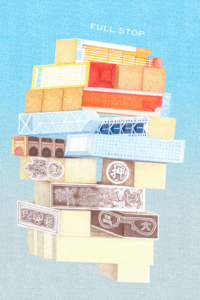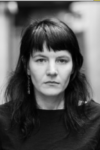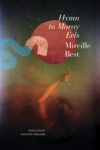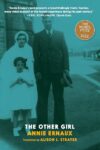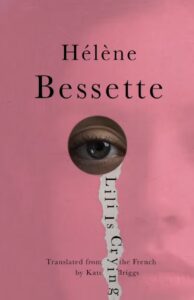
[New Directions, 2025]
Tr. from the French by Kate Briggs
Imagine if a novel were a painting. Imagine if it could speak visually, through voices manifested in marks on a page. Imagine if it could sing. Published originally in France as Lili pleure in 1953 and translated into English by Kate Briggs for a new edition by New Directions, Hélène Bessette’s Lili is Crying poses as a vast and intimately rendered image, the landscape always lush, here stormy and charged with resentment, there tranquil. Like a painting, the novel is more situation, less story. Lili and her mother Charlotte are unusually close—the term used today would be “codependent”—and why not? Charlotte has raised her on her own, has not needed a husband for herself or a father for her girl, has never left her wanting in their rural French home with its trees and its garden and the consistent company of their boarders. They’re so close that no romantic interest, no man’s presence stands a chance against the force of Charlotte’s love and need for Lili.
The novel opens with the blistering aftermath of this bond, the passionate personalities that make such a bond possible. As a reader, you sense all of this from a static first scene, heavy with ominous tone. First, Bessette describes the scene: “He is driving his sheep down the stony footpath that edges the garden beneath the ruined tower set high on the parched, barren hillside, bleached white in the Provençal sun.” Then, she makes it quake: “A wind swirls. A block of wall crumbles.” Then, Charlotte’s cloying calls: “Lili, Lili, where are you Lili? My Lili.” “Thank heavens, my Lili, that you and me, you the daughter and me the mother, we love each other in life and can shelter here together in this good and gentle Provençal house.” Their home is an island of forced calm as the world outside storms with “hell, damnation, cruelty, lies, deceit, betrayal, tears, severances, assassination, calumny, perfidy, misery, and death.” The scene absorbs the reader in its undercurrents, showing her quickly how to read its unconventional brushstrokes—the enjambed and distended lines, the unusual use of punctuation—at the same time as she hears the voices echoing through them. Entering these first pages of the book, my thought was, what did I just walk into?
Within the literary canon of mother-daughter relationships, Lili is Crying occupies an interesting space between books like Annie Ernaux’s En Femme (1988), translated as A Woman’s Story by Tanya Leslie, in which Ernaux commemorates her mother as an individual disentangled from motherhood, and more recently Avni Doshi’s novel Burnt Sugar (2019), whose narrator admits—“I would be lying if I said my mother’s misery has never given me pleasure”—confessing to a hatred stemming from the way her mother always prioritized her own desires. Translated from the Bangla by Shabnam Nadiya, Leesa Gazi’s Good Girls (2023) comes a step closer to Lili and Charlotte’s relationship—in Gazi’s novel, two forty-year-old daughters have been so protected by their mother that they have never ventured into their city alone, let alone form meaningful connections with anyone outside of their home. Their imprisonment rots their family from the inside. Perhaps the closest resemblance to Lili and Charlotte lies in the most famous pop culture reference that we have in the West for toxic mothers: for much of Bessette’s novel, Charlotte’s motto echoes Mother Gothel’s song from Disney—mother knows best.
Absent mothers beget resentment or yearning in their daughters; overpresent mothers make their hearts fester. The more nuanced of these stories explore complex relationships between women fastened within the invisible but pertinent power exerted by patriarchy. More often than not, though, as in the multiple versions of Rapunzel’s tale dating from the Brothers Grimm to Disney, the daughter’s freedom, maturity, and happy ending are promised through her rescue by a man. Lili is Crying grapples with similar concerns, but it asks what happens to these relationships, to mother and daughter as individual women, when men and climactic narrative arcs are beside the point, when there is an excess of love and companionship and nowhere left for either of them to go but to each other. What happens when a mother is both over-loving and passionately invested in her own power? What happens when her daughter becomes the receptacle of that power?
Hélène Bessette’s work reaches us now by way of her translator Kate Briggs by way of Iris Murdoch, who in a letter dated May 26, 1957, thanked Raymond Queneau for mailing her a package of Bessette’s novels. Reading and annotating her way through Murdoch’s published letters, sometime in 2019, Briggs was left curious by this unfamiliar name.
Bessette was born in 1918, her parents a taxi driver and a perfumer, in the Levellois-Perret commune of north central France. She worked as a schoolteacher, married a pastor, and spent three years with him in New Caledonia. She gave birth to two children, divorced her unfaithful husband, and returned to France with the custody of one child. In France, at 34 years old, her stories found a reader in Raymond Queneau.
It isn’t hard to see why the formal experiments of her writing would appeal to Queneau, a poet and novelist who in 1960 would co-found the French experimental writing group known as OuLiPo. In the company of authors like Georges Perec and Italo Calvino, OuLiPians would test the limits of writing under constraint. “Finally, something new!” were Queneau’s words upon encountering the writing of Hélène Bessette. In 1952, he was an editor at the French publishing house of Gallimard when he signed a ten-book deal with Bessette. Soon after, noted critics of twentieth-century France became engrossed in her voice. She published Lili pleure (1953), her first novel, for which she won the Prix Cazes, then a novel called maternA (1954) exploring early-years education, followed by an experimental detective fiction called Vingt minutes de silence (1955). Echoing her experience of working in and navigating the urban landscape of Sydney, Australia in 1948-49, her 1960 novel La route bleue shared Lili pleure’s use of geographical texture as form. Bessette went on to publish thirteen novels in addition to poetry collections, a radio drama, a play. And though she would later slip into oblivion—“Following the commercial failure of Ida ou le délire in 1973, and especially after Queneau’s death in 1976, her publisher ceased to support her. She died in poverty, in poor mental health, in 2000,” Kate Briggs wrote for The Yale Review—Bessette was a prominent voice in post-war avant-garde French literature. Eimear McBride’s Afterword for Lili is Crying reminds us that she “stoically retained her independence and disdained all attempts to affiliate herself, or her work, with any of the popular literary movements of the day.” “Le roman poétique,” is how she described the literature she was creating—a poetic novel, “as much an object of the eye as of the mind.”
Lili is Crying shifts every time you begin to make sense of it. Its four uneven parts move through Lili’s life from youth to middle age, through three romantic relationships soured by Charlotte’s intrusions. Charlotte and Lili’s is the only connection that survives Lili’s fraught attempts to become a wife, a mother, a lover; it survives also the gossipy cacophony of their friends and neighbors in Provence, as well as the economic hardships brought to their community by the second world war. The impulses that draw Lili to her romantic entanglements are too briefly rendered to leave an emotional mark on the reader. We feel the precarity of her affections for a marriage she has committed to with misplaced convictions, but not so much the passion that seems to beget a greater love in her life. We are moved, more, by the compassion, the generous interiority with which Bessette depicts her flawed characters, especially the man Lili marries, even if you don’t always root for their relationships with each other. A more painful heartbreak occurs from watching Lili getting torn between her love for Charlotte and her need for independence; closer to middle age, her dark thoughts about her own waning value as perceived by men and society are some of the book’s most harrowing reflections. What further complicates their life is that, despite Charlotte’s suffocating grip, the women in this novel are most at peace when they are with each other. Even the days of war, with all the men away, offer blissful harmony for Lili and Charlotte. When Lili is alone with the men she loves, their violent and entitled ways, their shallow emotional intelligence always leave her disappointed.
And still, most exciting is the structure through which this story unfolds.
We move through Lili’s life in great gulps of time, one unnamed, unnumbered chapter at a time, and those chapters in turn fragment into loosely connected scenes performing unwieldy jumps into the future—often as we’re halfway through what one might call a sentence. Fleeting phrases or a throwaway flashback are the only moves resembling exposition. Bessette wrests the reader out of her reliance on context for comprehension, asking her to look, really look at the image emerging through each scene, and from its finer details deduce what has changed recently in Lili’s life.
A more visual splintering happens in the enjambed lines on the page, which in some sections excavate a feeling, a thought, an experience by stacking synonyms. Space rendered with abstract brushstrokes alludes to scenes elsewhere. When Lili’s husband—“a Slav” who gets deported to Dachau during the war—struggles to form a connection with his mother-in-law: “…between the sounds of dishes being washed joylessly, gleamlessly, amid the noises of their evening meal: separation, rancor, bitterness, complaint, imprecations, regrets, memories, disappointed hopes, woes,” . . . “the faint glow of yellow light throws shadows of the couple’s weary gestures onto the wall.” In other scenes, an arbitrary typographical logic complicates our sense of who is speaking when and how. Consider this tensed beginning to a pivotal chapter in the book:
—So she did go! says Élise. I would never have thought she’d leave.
But she did.
—It’s like this, cries Lili, I refuse to go off with the man I do love.
Instead, I go off with the man I don’t love.
She left, says Marthe, but without saying a word.
She just said something about a couple of days’ rest at the sea-side.
—That’s what she told us.
—That’s what she told her mother.
Some dialogues in this novel begin and end without any punctuation, but in most lines as in this excerpt, Bessette opens her dialogues with em dashes. They serve as both a visual branch into the speaker’s interiority and an entry point into conversations underway. And with each new em dash in this particular quote, we hear from a different speaker continuing a potentially different conversation. While Marthe and Élise seem to be talking to each other, or perhaps to others, about their friend Lili in the third person, in between their whispers we hear what Lili herself has to say about her bid for freedom. Whether she’s speaking to herself or to her friends is ambiguous. But look even more closely at the lines without em-dashes—the “But she did,” the “Instead, I go off with…,” and it becomes unclear as to whether Élise and Lili are saying them out loud at all. Are they speaking to themselves in silent, trailing thoughts? Or is the narrator speaking to us instead? “It is not always clear when … public speech starts and private speech ends,” Kate Briggs writes in her translator’s note for the novel. “In a practice so alive to the visual qualities of the page as Bessette’s, it made sense to reproduce her em-dashes as a way of maintaining (rather than resolving) these stretches of uncertainty.”
Such structural playfulness connects nearly all of the projects bearing Kate Briggs’s touch. Raised in Somerset, UK, Briggs is an author and translator based in the Dutch port city of Rotterdam, where she teaches writing at the Piet Zwart Institute and co-runs the publishing project she founded and called “Short Pieces That Move.” A glance through their Instagram page presents a curious collection of short stories about interactions between bodies, societies, and objects; the pieces come from writers and artists working across media, located across Europe, and are accompanied by piercingly simple sketches stuck as though in motion. In the online workshop component of the project, writers gather virtually on a rise-up pad—a tool in which multiple users work on the same text document—to respond to writing prompts, borrowing, using, and offering up sentences to and from each other that eventually form a multi-layered text.
Briggs’s books perform a similar stretching of what a canon might define as literature. In The Preparation of the Novel, which Briggs translated from the French in 2010, Roland Barthes collects a series of lectures that he designed for the Collége de France between 1978-80. In the lectures, Barthes lays bare in real time the stages and struggles of writing a novel, moving from “short, concise notations” to “longer, uninterrupted flows of narrative.” Briggs’s translation pays attention to the nuances of the French, naturally, but she also hovers long and hard to ensure that it retains the oral cadences of a text that had “been written to be spoken.” The books she has authored herself linger similarly in these liminal spaces between artmaking. In This Little Art (2017), Briggs stitches a book-length essay—a sinewy, uneven string of observations formally reminiscent of Lili is Crying—about her process of translating Barthes’s lectures, exploring what it entails to read and engage with art created by another. In The Long Form (2023), named after the phrase Barthes used to describe the novel, Briggs unfolds a day in the life of a mother (named Helen, incidentally) and her infant, lingering this time in the moments of patience, attention, and perseverance that connect caregiving with the practice of novel writing.
Form, instead of distracting us from the story, is integral. In Briggs’s translation, Lili is Crying’s structural fragmentation echoes the fractured psyche of Bessette’s characters—how much they say to each other while communicating so little, how much they repress while performing an excess of their emotions. We feel inhabited by Charlotte’s fears of abandonment, Lili’s dilemma between desire and daughterly love, and even the grief felt by Lili’s husband as he strives to build a family with the two women, all because Briggs so evocatively captures their voices. If Charlotte’s voice is tinged consistently with pride while flitting between other emotions, doting on Lili, instructing her, blaming and berating her with surprising cruelty whenever she tries to act independently, Lili’s voice is at times giddy with romantic love and at others dejected, self-effacing, forcefully cheerful with the loyalty she feels for her mother. Briggs retains a subtle distinction between their tones, imbues even the voices of Marthe and Élise with the choral quality of a community in conversation, all while washing the text with a slightness of language, a musicality that holds the story and its characters at a mythical distance. Their life begins to sound like lore, like a fabled song heard in fragments through a chain of retellings.
This is a complex story of how much emotional and physical space a woman can command—the answer is neither simple, nor one that’s trying to satisfy. In the absence of larger character arcs, which might disappoint some of her readers, Bessette widens the scope of her novel to show us two women stuck in the loop of their circumstances, and in so doing asks the reader to step closer and look at the ceaseless, imperceptible moments in which they crack, scatter, and persevere. In locking Lili away from success in love or even motherhood, which might have leveled her with Charlotte, Lili is Crying resists stenciling the life of a woman and a novel within patriarchal milestones. It flouts our expectations of what would bring meaning and value to their lives. Ultimately, both the novel and its women remain out of our grasp.
Sarah Anjum Bari is a Bangladeshi writer and editor pursuing an MFA in nonfiction writing at the University of Iowa, where she also teaches literary publishing. Her writing has appeared in The Daily Star, Wasafiri, Literary Hub, Electric Literature, Himal Southasian, and elsewhere. Her essay, “Strains,” was shortlisted for the Wasafiri Queen Mary New Writing Prize 2024.
This post may contain affiliate links.


